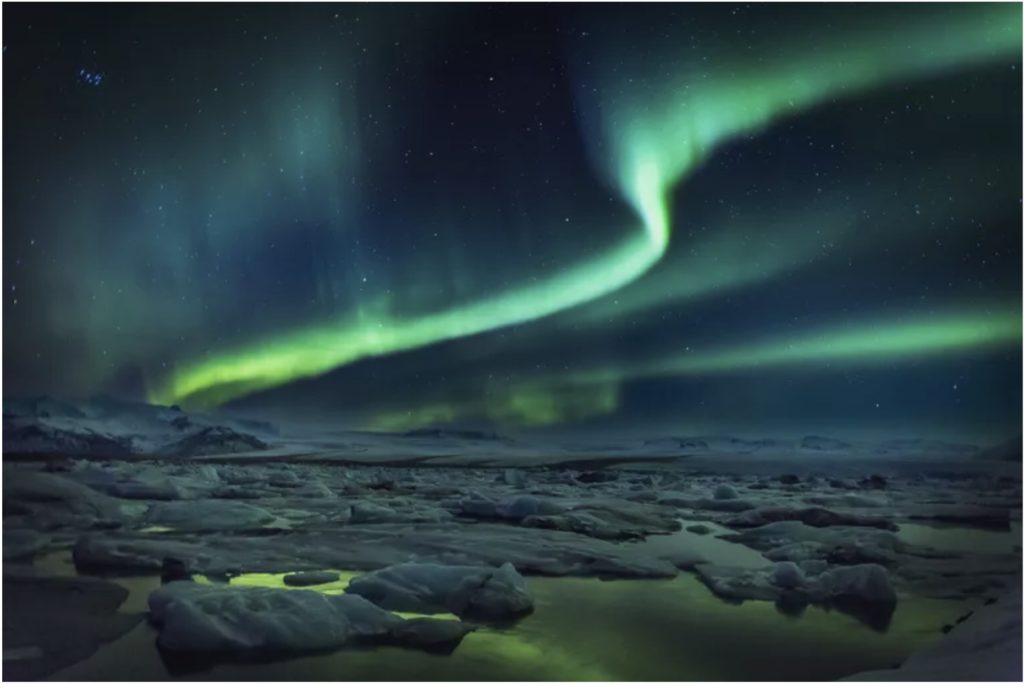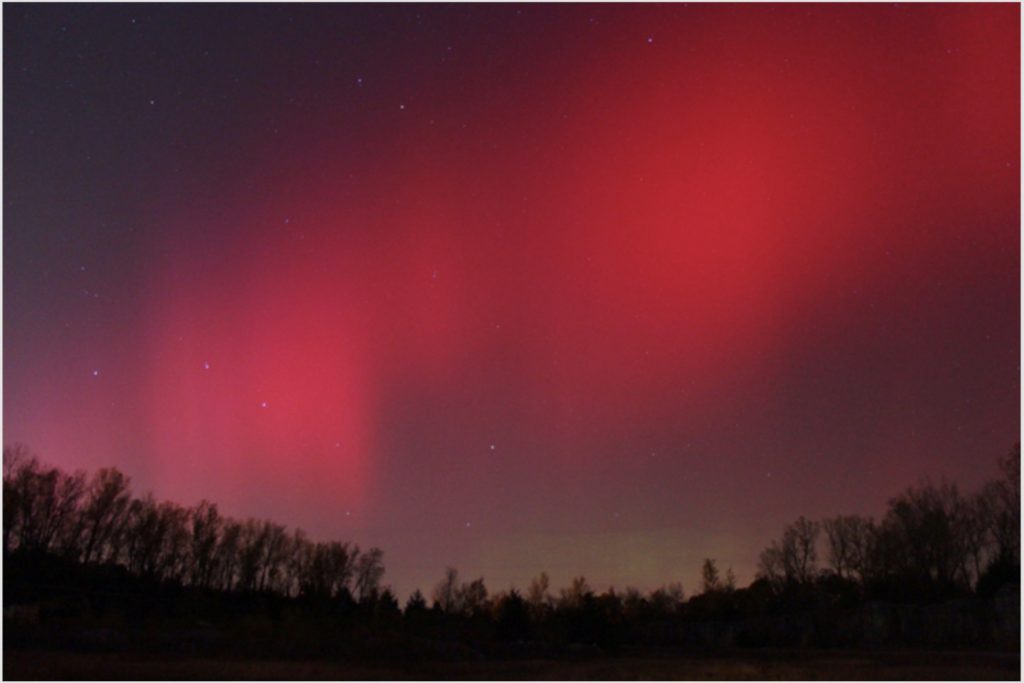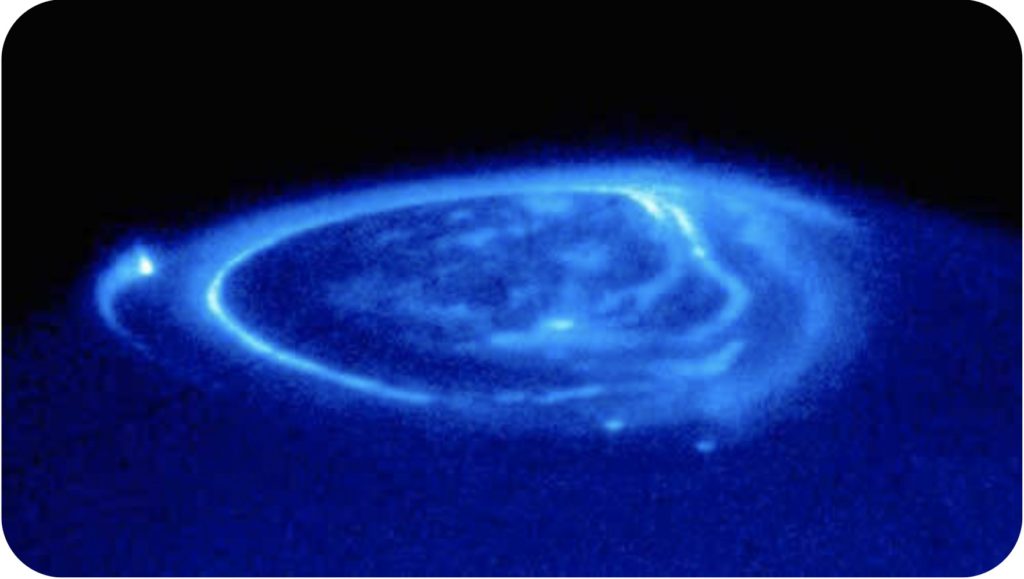How Does an Aurora Form?
An aurora is a natural phenomenon caused by the interaction between high-energy particles (electrons) and neutral atoms in the Earth’s upper atmosphere. These high-energy particles can excite (by collisions) valence electrons that are bound to the neutral atom. The excited electrons can then return to their initial, lower energy state and release photons in the process.
Auroras and the Solar Wind

As the solar wind approaches the Earth, it meets the Earth’s magnetic field. Without this magnetic field protecting the planet, the solar wind would blow away Earth’s fragile atmosphere. Most of the solar wind is blocked by the magnetosphere, and the ions forced around the planet continue to travel farther into the solar system.
Although the magnetosphere blocks most solar wind, some of the ions become briefly trapped in ring-shaped holding areas around the planet. These areas, situated in a region of the atmosphere called the ionosphere, are centered around the Earth’s geomagnetic poles. The geomagnetic poles mark the tilted axis of the Earth’s magnetic field. They lie about 1,300 kilometers (800 miles) from the geographic poles but are slowly moving.
In the ionosphere, the ions of the solar wind collide with atoms of oxygen and nitrogen from the Earth’s atmosphere. The energy released during these collisions causes a colorful glowing aurora. Most auroras happen about 97-1,000 kilometers (60-620 miles) above the Earth’s surface.
The most active auroras happen when the solar wind is the strongest. The solar wind is usually fairly constant, but solar weather, the heating, and cooling of different parts of the sun can change daily.
Some increased activity in the solar wind happens during every equinox. These regular fluctuations are known as magnetic storms. Magnetic storms can lead to auroras being seen in the mid-latitudes around the spring and autumnal equinoxes. Auroras have been visible as far south as the Yucatan Peninsula in Mexico.
Magnetic storms and active auroras can sometimes interfere with communications. They can disrupt radio and radar signals. Intense magnetic storms can even disable communication satellites.
The Color of Auroras
The colors of the aurora vary, depending on the altitude and the kind of atoms involved. If ions strike oxygen atoms high in the atmosphere, the interaction produced a red glow. The most familiar aurora, which has green-yellow color, occurs as ions strike oxygen at lower altitudes. Reddish and bluish light that often appears in the lower fringes of auroras is produced by ions striking nitrogen atoms. Ions striking hydrogen and helium atoms can produce blue and purple auroras, although our eyes can rarely detect this part of the electromagnetic spectrum.


When and Where?
The aurora borealis most commonly occur between 60°-75° latitude, but during great geomagnetic storms, the auroral oval expands equatorially and can reach 30° latitude or further. In the northern hemisphere, they are called the aurora borealis, and in the southern hemisphere, aurora australis.
Do Other Planets Get Auroras?
Auroras are not just something that happens on Earth. If a planet has an atmosphere and magnetic field, it can have auroras. Auroras were observed on Jupiter and Saturn.


[1][IMAGE] Regent. “South Iceland Winter Break”. https://www.regent-holidays.co.uk/tour/south-iceland-winter-break/. Last Accessed: 2020/10/06.
[2][5][6] NASA Science. “What Is an Aurora?”. https://spaceplace.nasa.gov/aurora/en/. Last Accessed: 2020/10/06.
[3] Helmenstine, Anne. (2019). “What Causes the Aurora Borealis’ Colors?”. https://www.thoughtco.com/causes-aurora-borealcolors-607595. Last Accessed: 2020/10/06.
[4] NASA. “Beautiful Red Aurora”. https://www.nasa.gov/mission_pages/sunearth/news/News102511-aurora.html. Last Accessed: 2020/10/06.
[7] National Geographic. “Aurora”. https://www.nationalgeographic.org/encyclopedia/aurora/. Last Accessed: 2020/10/06.
